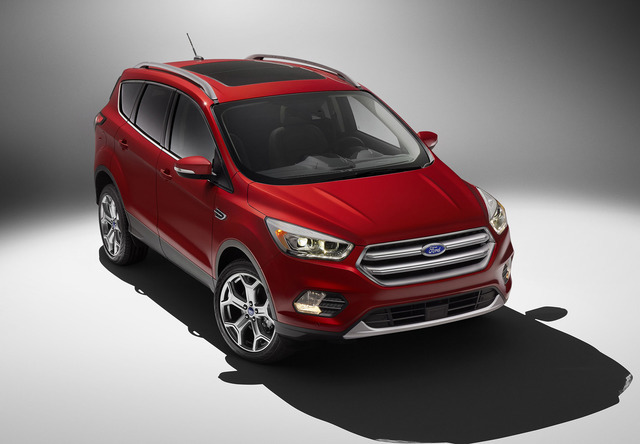Popular Ford Escape gets tweaked

The automotive industry calls it a midcycle refresh. It usually occurs around the halfway point of a vehicle’s lifespan — before a full redesign — and can mean anything from a new grille and taillights to something akin to a major overhaul. You can place the 2017 Escape — now in dealer showrooms — mostly in the cosmetic category.
As Ford’s second most popular vehicle (behind the Ford F-150 pickup), the blue-oval automaker deemed that a nip here and a tuck there was all that was necessary to keep the small and tall wagon up with the times.
And the times they are a booming for compact tall wagons. After all, they’re convenient, easy on gas, and, if you don’t go whole hog on options, they’re relatively affordable. What’s not to love?
For the 2017 model year, there’s a larger trapezoidal grille that’s more in line with the look of other Ford models. At the back, a new liftgate and taillights are installed. The Escape remains quite the handsome devil, only now it looks similar to the midsize Edge.
Inside, the traditional hand brake has been replaced with an electronic activator and the gear shifter has been relocated slightly aft to the spot where the brake lever used to be. This allows easier access to the control panel and a newly created small stowage bin.
There’s also an enlarged floor console and center armrest plus revised steering-wheel-mounted controls. The touch-screen remains a bit too bulbous, but that subjective quibble is a minor one.
As before, Escape buyers pick from three powerplants, but with some revisions. The 2.5-liter four-cylinder that’s exclusive to the base S model is unchanged at 168 horsepower and 170 pound-feet of torque, however the two optional turbocharged four-cylinders are new.
A 1.5-liter engine that produces 179 horsepower and 177 pound-feet of torque occupies the midrange position, while a 2.0-liter unit rated at 245/275 is the top performer. Output from the turbo engines varies only slightly from their predecessors. Six-speed automatic transmissions (with paddle shifters for turbo models) continue to handle the cog-swapping duties.
Interestingly, the Escape’s engine range is closely matched in terms of fuel economy with the win going to the 1.5-liter turbo (23 mpg in the city and 30 mpg on the highway). For the turbo engines, auto start-stop shuts them off at red lights and in gridlocked traffic to help their city mpg numbers. All-wheel drive can be ordered with either turbo engine and only slightly affects fuel consumption.
At a base price of $24,500, the front-wheel-drive Escape S has most of the basics, but you do get the latest version of Ford’s voice-controlled Sync communications and entertainment system.
Drop an extra $1,500 on the SE and content levels rise to include dual-zone climate control, fog lamps and additional trim.
It’s a extra $4,000 hit for the top-level Titanium, but you’ll get a number of active safety features (emergency braking and lane-keeping, for example) plus leather-trimmed seats, premium Sony audio package, remote start and the power liftgate that opens by shaking your foot under the bumper.
From that point, the options list is extensive. The more prominent features include a large sunroof, navigation system, heated steering wheel, front and rear protective skid plates and a sport appearance package.
No doubt the 2017 Escape has received some change for the sake of change, but in most cases buyers will have little problem with Ford keeping its popular wagon in tune with the times.